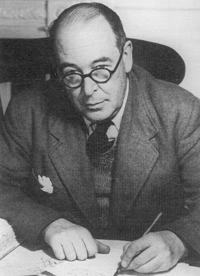Today marks 50 years since the death of the indefatigable Clive Staples Lewis. His legacy is enormous, and enormously important, but his intense concern for animals is an aspect of that legacy that is sometimes overlooked.
Anyone familiar with the major characters in The Chronicles of Narnia series might be able to guess that C.S. Lewis had a deep love for non-human animals. An orthodox Anglican Christian who was interested in providing a public and rational defense of his faith, Lewis was particularly bothered by the vast amount of suffering in a world created by a loving God. While he was of course concerned about the suffering of human beings, he also gave an incredible amount of attention to the suffering of non-human animals. This concern was expressed in his famous essay ‘On the Pains of Animals’, in a chapter on animal suffering in his classic work The Problem of Pain, and in an entire a book on animal experimentation which he simply called Vivisection. As a teenager, Lewis had rejected his Christian upbringing in favor of atheism. But on the basis of conversations and arguments with his devout Roman Catholic friend and fellow University of Oxford professor J.R.R. Tolkien, C.S. Lewis returned to his faith. Lewis and Tolkien met weekly in an Oxford pub called The Eagle and Child and the conversations between them, among other things, focused on their mutual love of non-human animals.
Many of Lewis’ letters survive today, including some responses to children who would write him about his animal characters in his books. His responses reveal a man with deep concern and love for animals, including a willingness to alter one’s lifestyle to make room for them. In one letter, for instance, he tells a child of a rabbit in the gardens at Magdalen College, Oxford he has named Baron Biscuit. Lewis would feed this rabbit from his hand and even wrote a poem about him and sent it to his young correspondent. Lewis wrote to another child that he had with him at the Kilns a dog named Bruce, and cats named Kitty-koo and Pushkin. It was in these letters that Lewis confided he never set traps for mice and in fact he had many living in his rooms at Oxford.
In a thirteen year correspondence he kept with an American woman, Lewis revealed several surprising views of interest to readers of this blog:
I ventured the supposal—it could be nothing more—that as we are raised in Christ, so at least some animals are raised in us. Who knows,indeed, but that a great deal even of the inanimate creation is raised in the redeemed souls who have, during this life, taken its beauty into themselves.That may be the way in which the ―new heaven and the new earth are formed. Of course we can only guess and wonder. But these particular guesses arise inme, I trust, from taking seriously the resurrection of the body: a doctrine which now-a-days is very soft pedaled by nearly all the faithful—to our great impoverishment…the spiritual evils we share with the devils (pride, spite) are far worse than what we share with the beasts.




